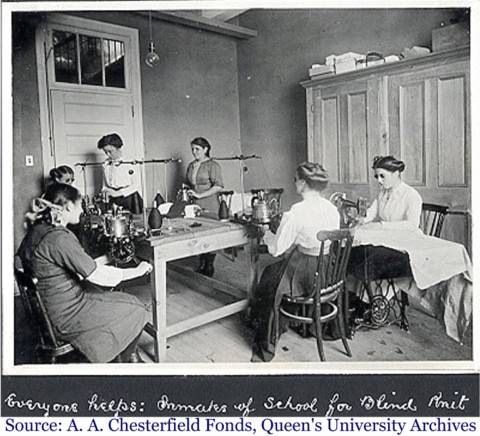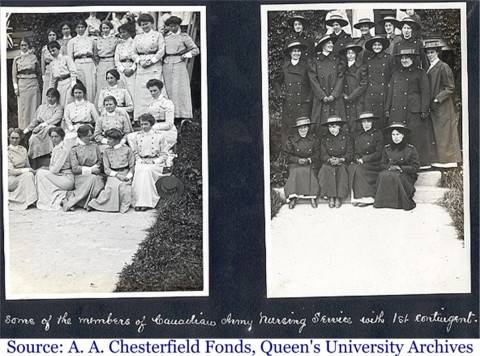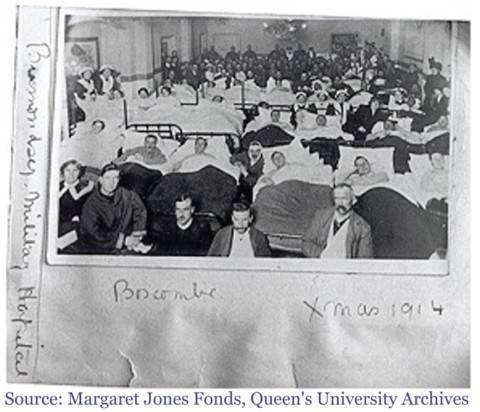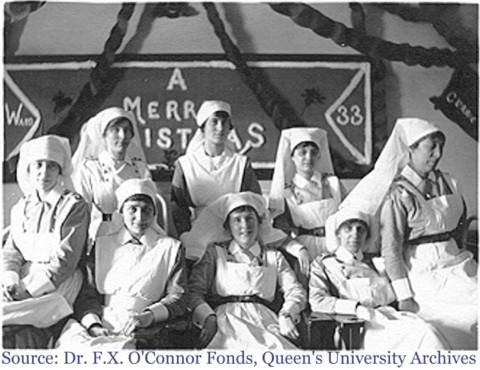
This is a propaganda poster that was directed towards the women of Canada during World War I. This poster sends a very strong message to women, urging them to give their husbands and sons permission to join the war effort. For much of the war it was against the law in Canada for a married man to enlist without the written permission of their spouse. Many women did refuse to give their husbands permission to enlist. In response these types of posters tried to make Canadian women feel guilty for not offering their men to the war effort. This type of propaganda was common during World War I because of the almost instant respect and honor that a soldier and his family gained by going off to war. Women were often seen walking through the streets trying to encourage all able bodied men to enlist. Many Canadians still saw war as a glorious and heroic event.

This picture was taken in Canada at a school for the blind. These young ladies are knitting and sewing items to be shipped overseas to the front. This is a good example of the kinds of contributions made by Canadian women during World War I. Almost everyone in Canada was involved with the war effort in some way. Women made things like pillows, sheets, flannel shirts, socks, cholera belts wristlets, balaclavas, and scarves. Many Canadian women tried to do more but were discouraged by their social status and by rules established by the Canadian government. For example, women in Toronto tried to form the "Women's Home Guard" (a group of women to be trained as soldiers to protect Canada's homefront and free up men in the official "Home Guard" for overseas duty) but it failed because of strong opposition within Canada. Canadian women did form the "Suffragists' War Auxiliary", designed to provide women to do the jobs of men to free them up for overseas duty. Over 30,000 women worked in munitions factories, more than 5,000 were employed in the civil service, thousands more worked in banks, offices, factories, and on farms, while over 1000 women were employed by the Royal Air Force (e.g., motor transport work, mechanical work, and as ambulance drivers).

This is a picture of some of the women who were part of the Canadian Army Nursing Service during WWI. Nursing is the most prominent role that Canadian women played at the front in Europe. Over 2000 women enlisted as nursing sisters in the Canadian Expeditionary Force during WWI. The role of women at the front was very limited because of army rules and social constraints. The women of Canada started an organization called ,"The Canadian Women's Hospital Ship Fund". They raised money by organizing concerts, tag days, teas, card parties, lectures, and bazaars. Women also raised money for the Red Cross, Belgian Relief, and Canadian Patriotic Fund. World War I did help suffragist groups break some of these social barriers. As a result, on September 20, 1917 the vote was given to women, whose husbands, sons, and brothers had served in the war.


The first photo is a picture of some Canadian nurses during World War I (Ward 33). This picture was taken at Christmas time. The hospital is well decorated for the occasion, in hopes of cheering up the wounded. One of the biggest tasks of a WWI nurse was to comfort the wounded and give them hope of a healthy return home.
The second photo is another picture of a military hospital, taken around Christmas time in 1914. Military hospitals were almost always overcrowded and understaffed during WWI. Often times there were not enough beds for the wounded.